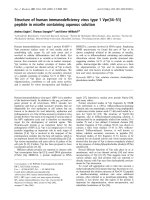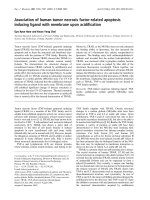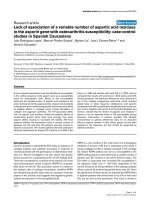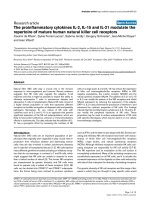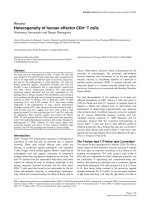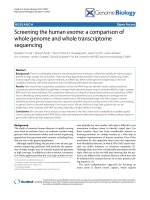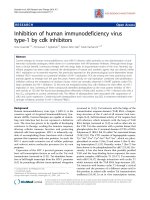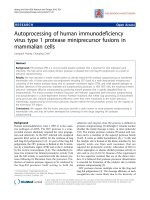Báo cáo y học: " Newly described human polyomaviruses Merkel Cell, KI and WU are present in urban sewage and may represent potential environmental contaminants" potx
Bạn đang xem bản rút gọn của tài liệu. Xem và tải ngay bản đầy đủ của tài liệu tại đây (516.03 KB, 5 trang )
Bofill-Mas et al. Virology Journal 2010, 7:141
/>Open Access
SHORT REPORT
© 2010 Bofill-Mas et al; licensee BioMed Central Ltd. This is an Open Access article distributed under the terms of the Creative Commons
Attribution License ( which permits unrestricted use, distribution, and reproduction in
any medium, provided the original work is properly cited.
Short report
Newly described human polyomaviruses Merkel
Cell, KI and WU are present in urban sewage and
may represent potential environmental
contaminants
Sílvia Bofill-Mas*, Jesus Rodriguez-Manzano, Byron Calgua, Anna Carratala and Rosina Girones
Abstract
Recently, three new polyomaviruses (KI, WU and Merkel cell polyomavirus) have been reported to infect humans. It has
also been suggested that lymphotropic polyomavirus, a virus of simian origin, infects humans. KI and WU
polyomaviruses have been detected mainly in specimens from the respiratory tract while Merkel cell polyomavirus has
been described in a very high percentage of Merkel cell carcinomas. The distribution, excretion level and transmission
routes of these viruses remain unknown.
Here we analyzed the presence and characteristics of newly described human polyomaviruses in urban sewage and
river water in order to assess the excretion level and the potential role of water as a route of transmission of these
viruses. Nested-PCR assays were designed for the sensitive detection of the viruses studied and the amplicons
obtained were confirmed by sequencing analysis. The viruses were concentrated following a methodology previously
developed for the detection of JC and BK human polyomaviruses in environmental samples. JC polyomavirus and
human adenoviruses were used as markers of human contamination in the samples. Merkel cell polyomavirus was
detected in 7/8 urban sewage samples collected and in 2/7 river water samples. Also one urine sample from a
pregnant woman, out of 4 samples analyzed, was positive for this virus. KI and WU polyomaviruses were identified in 1/
8 and 2/8 sewage samples respectively. The viral strains detected were highly homologous with other strains reported
from several other geographical areas. Lymphotropic polyomavirus was not detected in any of the 13 sewage neither
in 9 biosolid/sludge samples analyzed.
This is the first description of a virus isolated from sewage and river water with a strong association with cancer. Our
data indicate that the Merkel cell polyomavirus is prevalent in the population and that it may be disseminated through
the fecal/urine contamination of water. The procedure developed may constitute a useful tool for studying the
excreted strains, prevalence and transmission of these recently described polyomaviruses.
Findings
Human polyomaviruses JC and BK (JCPyV and BKPyV)
are two members of the Polyomaviridae family that per-
sistently infect humans and cause disease in immuno-
compromised individuals. These viruses have been
potentially implicated in certain cancers [1,2]. Both respi-
ratory and oral routes have been postulated for their
transmission [3-5]. A high frequency of excretion of
JCPyV and BKPyV has been reported, and both viruses
have been detected in urban sewage from various geo-
graphical areas [6,7]. This observation indicates that they
could be transmitted by water or food.
In 2007 and 2008, three new polyomaviruses, KI WU
and Merkel cell polyomavirus (KIPyV, WUPyV and
MCPyV), were reported in humans [8-10]. KIPyV and
WUPyV have been detected mainly in respiratory tract
specimens from children and also immunocompromised
individuals. In 4 continents these viruses showed equiva-
lent prevalence and highly conserved nucleotide
sequences. KIPyV and WUPyV have also been co-
detected with other viruses in patients with respiratory
* Correspondence:
1
Department of Microbiology, Faculty of Biology, Universitat de Barcelona, Av.
Diagonal 645, 08028 Barcelona, Spain
Full list of author information is available at the end of the article
Bofill-Mas et al. Virology Journal 2010, 7:141
/>Page 2 of 5
and, in some cases, gastrointestinal disorders. Both
viruses have been detected in feces [11,12] and their role
in the etiology of respiratory infections has recently been
questioned [13].
MCPyV, which has also been described in respiratory
secretions [14-16], is strongly associated with Merkel cell
carcinomas (MCC) [17]. This association strongly sup-
ports an etiological role for MCPyV in the development
of MCC [18]. Recent serological data show that KIPyV,
WUPyV and MCPyV are prevalent in the healthy popula-
tion [19].
Antibodies against lymphotropic polyomavirus (LPyV),
a virus of simian origin, have been found in human blood
samples [19,20]. Moreover, LPyV has been reported in
human peripheral blood from patients with leukoenceph-
alopathies as well as in immunocompromised and healthy
subjects [21,22].
Here we assessed KIPyV, WUPyV, MCPyV and LPyV in
urban wastewater to determine whether these viruses are
prevalent in the environment, as reported for JCPyV and
BKPyV [7]. For this purpose, we performed nested-PCR
(nPCR) assays and compared our results with the nucle-
otide sequences available in data banks. Wastewater sam-
ples collected over the last 6 years from a treatment plant
processing domestic and industrial wastewater from a
population of 175,000 inhabitants were tested for the
presence of KIPyV, WUPyV and MCPyV (8 sewage sam-
ples) and also for LPyV (13 sewage and 9 biosolid and
sludge samples). In addition, 7 samples collected in 2009
from river water used to source a drinking water treat-
ment plant were also analyzed for the presence of KIPyV,
WUPyV and MCPyV. The presence of JCPyV and human
adenoviruses (HAdVs) was evaluated by quantitative PCR
(qPCR) as a control of the procedures applied and as an
index of the level of fecal pollution of human origin pres-
ent in the samples [6].
Urine samples collected from 4 healthy pregnant
women were also tested for WUPyV, KIPyV and MCPyV.
Viral particles were concentrated using methods devel-
oped in a previous study using JCPyV as a model. Metods
were based on: ultracentrifugation and elution of samples
with glycine buffer pH 9.5 for sewage [7] and sludge or
biosolids [6], glass wool columns filtration and glycine
buffer elution for river water [23] and on ultracentrifuga-
tion for urine [3]. Negative controls were established for
each batch of samples. Nucleic acids were extracted with
the QIAamp Viral RNA kit (QIAGEN, Inc.). Oligonucle-
otide primers (Table 1) were designed based on existing
polyomaviral sequences and their specificity against
other known polyomaviruses (JCPyV, BKPyV, SV40,
LPyV) was checked by nPCR. Samples were analyzed by
nPCR in final 50-μL reaction volumes. Briefly, 10 μL of
the extracted nucleic acids (corresponding to 2 mL of
sewage, 2.5 mL of sludge, 1 g of biosolids, 13.5 mL of river
water, and 2 mL of urine) and a 10-fold dilution (to pre-
vent enzymatic inhibition) of each nucleic acid extraction
were analyzed in a 40-μL reaction mixture containing
1xPCR Buffer, MgCl
2
at 1.5 mM, 0.025 mM of each dNTP,
0.5 μM of primers and 2 units of TaqGold DNA poly-
merase (Applied Biosystems). After a first-round PCR, 1
μL of the product was added to 49 μL of the nPCR mix-
ture containing the same components as the first-round
PCR mixture. The conditions for the first-round and
nPCR reaction conditions were as follows: 95°C for 10
min, 30 cycles of 94°C for 60 sec, 60 sec at the corre-
sponding annealing temperature (Table 1) and extension
at 72°C for 60 sec. Amplification was completed with a 7-
min extension step at 72°C. Amplicons of the expected
size were purified (QIAquick PCR purification kit, QIA-
GEN, Inc) and sequenced (BigDye sequencing kit and
ABI Prism 377 genetic analyzer; Applied Biosystems).
Nucleotide sequences were analyzed using the basic
BLAST program />.
Separate areas were used for the diverse steps of the pro-
cedures developed; non-template controls were included
in each nPCR reaction. HAdV and JCPyV were tested as a
control of the procedures applied as well as of the pres-
ence of enzymatic inhibitors in the samples.
We processed the samples as 3 separate batches at 3
separate periods of time. The samples showed typical lev-
els of human fecal pollution, as shown by JCPyV and
HAdV concentrations (Table 2). KIPyV and WUPyV were
present in 1/8 and 2/8 sewage samples respectively while
MCPyV was present in 7/8 sewage samples and was the
unique newly described human polyomavirus found in
the river water (Table 2). MCPyV was also detected in 1/4
urine samples. The VP1 and VP1/VP2/VP3 genes of the
MCPyV genome were also amplified and sequenced in 3
sewage samples to confirm the presence of MCPyV
genome (Table 2).
Although the detection technique used here was not
quantitative, limiting-dilution nPCR experiments showed
approximately 10-100 PCR units/mL of sewage for
KIPyV, WUPyV and MCPyV. Samples showed positive
results only after nPCR but not after the first-round PCR.
DNA cross contamination was ruled out since no viral
strains or plasmids with the genomes of the viruses were
available, only for LPyV was a plasmid available in the
laboratory as positive control; however, all samples were
found to be negative for this virus.
We found that the viruses showed a high degree of
sequence stability. All but one sequenced MCPyV ampli-
con were identical and also identical to the reference
sequence with GenBank accession number: EU375803
,
despite their distinct origins (sewage, river water or
urine). This observation confirms the high level of con-
servation of the DNA of these viruses. Only one MCPyV
VP1 amplicon showed a nucleotide that differed from the
Bofill-Mas et al. Virology Journal 2010, 7:141
/>Page 3 of 5
Table 1: Oligonucleotide primers used for nPCR amplification of WUPyV, KIPyV, MCPyV and simian polyomavirus LPyV
Primer Virus region Position Amplification
reaction
Product size (bp) Annealing
temperature (°C)
Sequence (5'-3')
WU1
WUPyV (VP1)
a
1730-1750 First 505 55 CCCACAAGAGTGCAAAGCCTTC
WU2 2234-2213 AGGCACAGTACCATTGGTTTTA
WU3 2044-2063 Nested 164 50 AGTTTTGGTGCTTCCTKTSC
WU4 2207-2188 TACAGTATACTGAGCAGGC
KI1
KIPyV (VP1)
b
1684-1704 First 378 59 GCTGCTCAGGATGGGCGTGA
KI2 2061-2043 CAGKGTTCTAGGGTCTCCTGGT
KI3 1899-1918 Nested 190 54 GTTGCTTGTTGTACCTCTAG
KI4 2088-2067 AATTGTATAGGTAGTTGGGCCT
MC1
MCPyV (TAg)
c
1716-1736 First 477 55 GCCTGTGAATTAGGATGTATTT
MC2 2210-2198 CATTTCTGTCCTGGTCATTTCCA
MC3 2010-2033 Nested 183 50 GCCCATTATCTAGACTTTGCAAA
MC4 2192-2173 TCTAACCTCCTTTTGGCTA
MC1b
MCPyV (VP1)
c
3174-3194 First 440 58 GGCTTTCTTTTTGAGAGGCCT
MC2b 3613-3592 AGTGGGCCCTCTATGCAAAGGA
MC3b 3276-3297 Nested 240 54 TTGGGTAAACAGTTTTCTCCTG
MC4b 3515-3493 TGCCTAGATATTTTAATGTTACT
MC1c
MCPyV (VP1/2/3)
c
4228-4252 First 265 53 GAATTAACTCCCATTCTTGGATTCA
MC2c 4492-4472 TTGGCTTCTTCCTCTGGTACT
MC3c 4264-4286 Nested 198 53 ATTTGGGTAATGCTATCTTCTCC
MC4c 4461-4439 GGATATATTTCTCCTGAATTACA
LN1
LPyV(VP2/VP3)
d
1542-1564 First 423 54 GGCACACCAAAGAGTAACTCAAG
LN2 1965-1943 CAGGTCATGTCTTCATTTAGGAG
LN3 1617-1639 Nested 232 54 GGAAGTGGAGCTTAATAAATTGG
LN4 1863-1849 ATATCCATACAAGTCCTCAGAAG
VP1, VP2 and VP3 = Virion protein 1, 2 and 3; TAg = T antigen; K= G +T; S = G + C
a
The sequence positions are referred to strain EF444549
b
The sequence positions are referred to strain EF127906
c
The sequence positions are referred to strain EU375803
d
The sequence positions are referred to strain K02562
others and from strain EU375803 although it does not
produce any change in the derived protein sequence.
The WUPyV amplicon sequenced was identical to ref-
erence strain EF444549 while the KIPyV amplicon
sequenced showed one nucleotide of difference with ref-
erence strain EF127906.
The nucleotide sequences obtained were deposited in
GenBank [GenBank: GQ376529
(WUPyV), GQ376528
(KIPyV), GQ376530 (MCPyV TAg region), GQ452776
(MCPyV VP1/VP2-VP3 region) and GQ390249/50
(MCPyV VP1 region)].
None of the 22 sewage, sludge and biosolid samples
tested positive for LPyV although typical concentrations
of JCPyV and HAdV indicated human fecal contamina-
tion (data not shown). The nPCR assay showed a sensitiv-
ity of 1-10 genomic copies/reaction when the complete
LPyV genome [24] cloned in pBR322 and quantified
spectrophotometrically was analyzed by limiting-dilution
nPCR. Thus, LPyV was not detected in the tested samples
by these methods.
The observation that MCPyV DNA was much more
frequently detected than that of KIPyV or WUPyV might
Bofill-Mas et al. Virology Journal 2010, 7:141
/>Page 4 of 5
reflect that MCPyV is a more prevalent infection or that
it is a highly excreted virus.
Our results on MCPyV in urine, urban sewage and river
water strongly support the notion that this virus shows an
excretion pattern that resembles that of JCPyV and
BKPyV. Human excretion of new polyomaviruses, espe-
cially MCPyV, may lead to fecal (urine) contamination of
water and food.
In this study we did not attempt the in vitro culture of
the new polyomaviruses because no cell culture systems
for these viruses are available at present. Furthermore, for
other human polyomaviruses, such as JCPyV, the regula-
tory regions of strains excreted in urine present an arche-
typal structure and are inefficiently cultured.
To our knowledge, this is the first report of the pres-
ence of a virus strongly related to human cancer in sew-
age and river water samples. We propose that the
methodology reported here is suitable to study the preva-
lence, excretion pattern and genetic variability of recently
discovered human polyomaviruses in environmental
matrices.
Competing interests
The authors declare that they have no competing interests.
Authors' contributions
SBM coordinated the study, concentrated urine samples and nucleic acid
extractions of the urine samples, collaborated in PCR assays, typed the ampli-
cons detected and drafted the manuscript. JRM concentrated the sewage and
biosolid samples and performed the nucleic acid extractions; he also collabo-
rated in the PCR analysis and in the sequencing of the resulting amplicons. BC
concentrated river water samples and performed nucleic acid extraction of the
same samples. AC collaborated in the production of standards for the quantifi-
cation of HAdV and JCPyV and in the nucleotide sequence comparisons. RG
participated in the development of the methodology, conception and coordi-
nation of the study and helped to draft the manuscript. All authors read and
approved the final manuscript.
Authors' information
SBM is an assistant professor at the Department of Microbiology of the Faculty
of Biology, University of Barcelona. Her main research interests are the epidemi-
Table 2: Presence of human polyomaviruses and human adenoviruses in sewage and river water samples
Samples,
type
Collection
date (month/
year)
Quantitative PCR (GC/mL of
sample)
Nested-PCR results (presence/absence)
HAdV JCPyV WUPyV KIPyV MCPyV (Tag)
BCN1, sewage 02/2004
2.81 × 10
3
1.35 × 10
3
+-
+
a
BCN2, sewage 07/2007
4.29 × 10
3
7.94 × 10
2
+
a
BCN3, sewage 07/2007
1.57 × 10
3
NT - -
+
a
BCN4, sewage 07/2007
6.10 × 10
3
8.65 × 10
2
+
a, b
BCN5, sewage 05/2008 Non tested
5.48 × 10
2
+
a
+
a
+
b
BCN6, sewage 09/2006
9.40 × 10
1
7.65 × 10
2
+
BCN7, sewage 11/2006
1.35 × 10
2
4.83 × 10
2
+
b
BCN8, sewage 12/2006
6.00 × 10
2
8.33 × 10
1
BCN9, river
water
03/2009
3.08 × 10
0
1.00 × 10
0
BCN10, river
water
03/2009
7.90 × 10
0
9.40 × 10
0
+
a
BCN11, river
water
03/2009
1.10 × 10
1
1.21 × 10
1
+
a
BCN12, river
water
03/2009
1.18 × 10
1
1.49 × 10
1
BCN13, river
water
03/2009
1.99 × 10
0
4.40 × 10
0
BCN14, river
water
03/2009
2.48 × 10
0
1.21 × 10
1
BCN15, river
water
03/2009
3.46 × 10
0
9.94 × 10
0
NT = Not tested
a
Sequenced amplicons
b
Samples from other regions (VP1 and/or VP1/VP2/VP3) in which MCPyV has been amplified and sequenced (GQ452776, GQ390249-50)
Bofill-Mas et al. Virology Journal 2010, 7:141
/>Page 5 of 5
ology of human and animal polyomaviruses. She addresses their transmission
through the environment and their potential as indicators of the presence of
human or/and animal fecal contamination.
Acknowledgements
This work was supported by the "Ministerio de Ciencia e Innovación, MICINN"
of the Spanish Government (project AGL2008-05275-C03-01/ALI) and by the
"Xarxa de Referència de Biotecnologia de Catalunya". We thank Dr. A. Lewis
(Food and Drug Administration, Maryland, USA) for kindly providing the LPyV
plasmid. Jesus Rodriguez-Manzano and Anna Carratala are fellows of the
MICINN. We thank the "Serveis Científico Tècnics" of the University of Barcelona
for sequencing of PCR products.
Author Details
Department of Microbiology, Faculty of Biology, Universitat de Barcelona, Av.
Diagonal 645, 08028 Barcelona, Spain
References
1. Barbanti-Brodano G, Sabbioni S, Martini F, Negrini M, Corallini A, Tognon
M: BKvirus, JC virus and Simian Virus 40 infection in humans, and
association with human tumors. Adv Exp Med Biol 2006, 577:319-341.
2. Lee W, Langhoff E: Polyomavirus in human cancer development. Adv
Exp Med Biol 2006, 577:310-318.
3. Bofill-Mas S, Clemente-Casares P, Major EO, Curfman B, Girones R: Analysis
of the excreted JC virus strains and their potential oral transmission. J
Neurovirol 2003, 9:498-507.
4. Monaco MCG, Jensen PN, Hou J, Durham LC, Major EO: Detection of JC
virus DNA in human tonsil tissue: evidence for site of initial viral
infection. J Virol 1998, 72:9918-9923.
5. Riccardiello L, Laghi L, Ramamirtham P, Chang CL, Chang DK, Randolph
AE, Boland CR: JC virus DNA sequences are frequently present in human
upper and lower gastrointestinal tract. Gastroenterol 2000,
119:1228-1235.
6. Bofill-Mas S, Albinana-Gimenez N, Clemente-Casares P, Hundesa A,
Rodriguez-Manzano J, Allard A, Calvo M, Girones R: Quantification and
stability of human adenoviruses and polyomavirus JCPyV in
wastewater matrices. Appl Environ Microbiol 2006, 72:7894-7896.
7. Bofill-Mas S, Pina S, Girones R: Documenting the epidemiologic patterns
of polyomaviruses in human populations by studying their presence in
urban sewage. Appl Environ Microbiol 2000, 66:238-245.
8. Allander T, Andreasson K, Gupta S, Bjerkner A, Bogdanovic G, Persson
MAA, Dalianis T, Ramqvist T, Andersson B: Identification of a third human
polyomavirus.
J Virol 2007, 81:4130-4136.
9. Feng H, Shuda M, Chang Y, Moore PS: Clonal Integration of a
polyomavirus in human merkel cell carcinoma. Science 2008,
319:1096-1100.
10. Gaynor AM, Nissen MD, Whiley DM, Mackay IM, Lambert SB, Wu G,
Brennan DC, Storch GA, Sloots TP, Wang D: Identification of a novel
polyomavirus from patients with acute respiratory tract infections.
PLoS Pathogens 2007, 3:595-604.
11. Mourez T, Bergeron A, Ribaud P, Scieux C, de Latour RP, Tazi A, Socié G,
Simon F, LeGoff J: Polyomaviruses KI and WU in immunocompromised
patients with respiratory disease. Emerg Infect Dis 2009, 5:107-109.
12. Neske F, Blessing K, Pröttel A, Ullrich F, Kreth HW, Weissbrich B: Detection
of WU polimavirus DNA by real-time PCR in nasopharyngeal aspirates,
serum, and stool samples. J Clin Virol 2009, 44:115-118.
13. Norja P, Ubillos I, Templeton K, Simmonds P: No evidence for an
association between infections with WU and KI polyomaviruses and
respiratory disease. J Clin Virol 2007, 40:307-311.
14. Dalianis T, Ramqvist T, Andreasson K, Kean JM, Garcea RL: KI, WU and
Merkel cell polyomaviruses: A new era for human polyomavirus
research. Sem in cancer biology 2009, 19(4):270-75.
15. Goh S, Lindau C, Tiveljung-Lindell A, Allander T: Merkel cell polyomavirus
in respiratory tract secretions. Emerg Infec Dis 2009, 15:489-491.
16. Kantola K, Sadeghi M, Lahtinen A, Koskenvuo M, Aaltonen LM, Möttönen
M, Rahiala J, Saarinen-Pihkala U, Riikonen P, Jartti T, Ruuskanen O,
Söderlund-Venermo M, Hedman K: Merkel cell polyomavirus DNA in
tumor-free tonsillar tissues and upper respiratory tract samples:
implications for respiratory transmission and latency. J Clin Virol 2009,
45(4):292-295.
17. Becker JC, Schrama D, Houben R: Visions and reflections (minireview).
Cell Mol Life Sci 2009, 66:1-8.
18. Hodgson NC: Merkel cell carcinoma: changing incidence.
J Surg Oncol
2005, 89:1-4.
19. Kean JM, Rao S, Wang M, Garcea RL: Seroepidemiology of human
polyomaviruses. PLoS Pathogens 2009, 5:1-10.
20. Viscidi RP, Clayman B: Serological cross reactivity between
polyomavirus capsids. Adv Exp Med Biol 2006, 577:73-84.
21. Delbue S, Tremolada S, Branchetti E, Elia F, Gualdo E, Marchioni E, Maserati
R, Ferrante P: First identification and molecular characterization of
lymphotropic polyomavirus in peripheral blood from patients with
leukoencephalopaties. J Clin Microbiol 2008, 46:2461-2462.
22. Delbue S, Tremolada S, Elia F, Carloni C, Amico S, Tavazzi E, Marchioni E,
Novati S, Maserati R, Ferrante P: Lymphotropic polyomavirus is detected
in peripheral blood from immunocompromised and healthy subjects.
J Clin Virol 2010, 47(2):156-160.
23. Calgua BA, Mengewein A, Grunert A, Bofill-Mas S, Clemente-Casares C,
Hundesa A, Wyn-Jones P, López-Pila JM, Girones R: Development and
application of a one-step low cost procedure to concentrate viruses
from seawater samples. J Virol Methods 2008, 153:79-83.
24. Pawlita M, Clad A, zur Hausen H: Complete DNA sequence of
lymphotropic papovavirus: prototype of a new species of the
polyomavirus genus. Virology 1985, 143(1):196-211.
doi: 10.1186/1743-422X-7-141
Cite this article as: Bofill-Mas et al., Newly described human polyomaviruses
Merkel Cell, KI and WU are present in urban sewage and may represent
potential environmental contaminants Virology Journal 2010, 7:141
Received: 30 November 2009 Accepted: 28 June 2010
Published: 28 June 2010
This article is available from: 2010 Bofill-Mas et al; licensee BioMed Centra l Ltd. This is an Open Access article distributed under the terms of the Creative Commons Attribution License ( ), which permits unrestricted use, distribution, and reproduction in any medium, provided the original work is properly cited.Virology Journal 2010, 7:141
